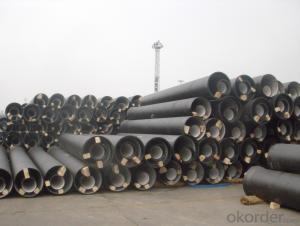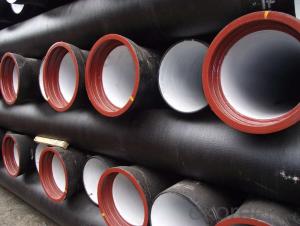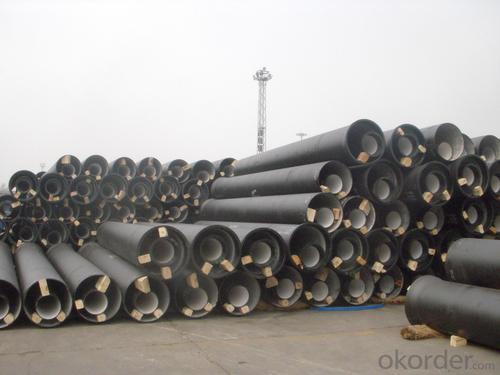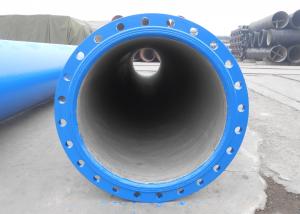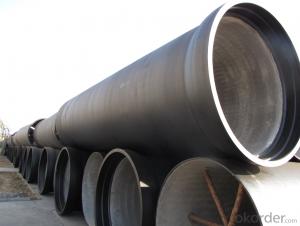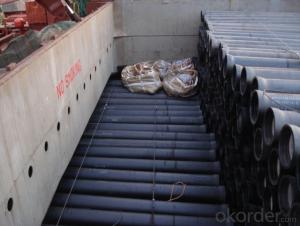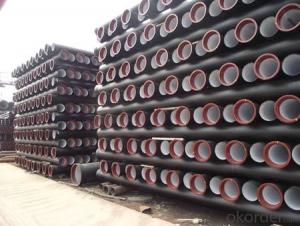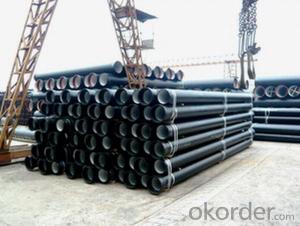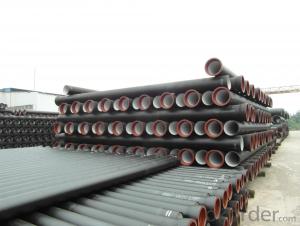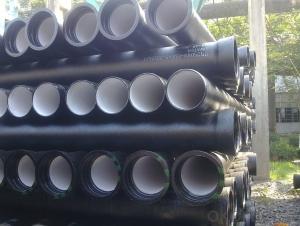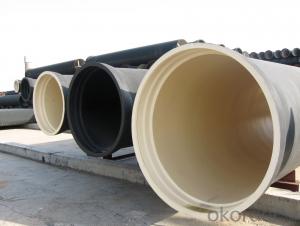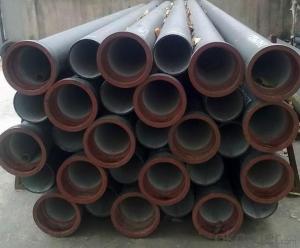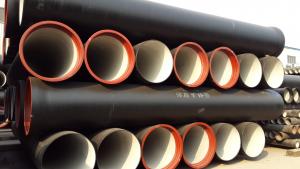Ductile Iron Pipe ISO2531:1998 DN200 K9
- Loading Port:
- Tianjin
- Payment Terms:
- TT or LC
- Min Order Qty:
- 20 m.t.
- Supply Capability:
- 200000 m.t./month
OKorder Service Pledge
OKorder Financial Service
You Might Also Like
1,Ductile Iron Pipe Description :
DI pipe fittings are manufactured according to ISO 2531 or BS EN545 or BS4772 FOR POTABLE WATER ,internal is cement lining or wet epoxy coating;External is zinc plus bitumen or wet epoxy coating. We also manufacture ductile iron fittings with fusion bonded epoxy both inside and outside. All the producets are sutible to water pipes fields.We have passed ISO9001,ISO14001,OHSMS18001certificate.
2,Main Features of the Ductile Iron Pipe:
·High tensile Strength
·High corrosion resistance
·Pressure Resistence
·Anti-corrosion
·Installation is convenient
·Satisfy the highest hygienic standards
1. Material: Ductile iron grade 500-7/ 450-10 in accordance with ISO1083
2. Standard: ISO 2531, EN545, EN598, ANSI, AWWA
3. Certificate: ISO9001, ISO14001, SGS, NSF, WRAS
4. Test: In accordance with ISO 2531 / EN 545 / EN598 and 100% water pressure test
5. Length: 6m or cut into 5.6m, 5.7m, 5.8m
6. Internal Lining: Cement, conform to ISO4179
3,Ductile Iron Pipe Images:
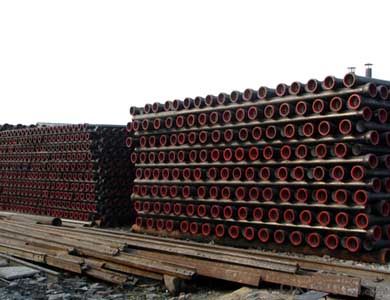
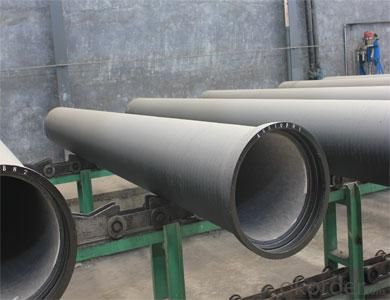
4.FAQ:
We have organized several common questions for our clients,may help you sincerely
Q: Why would you choose ductile iron pipe rather than other pipe materials?
A:The reasons are obvious for that not only ductile iron pipe possesses the inherent strength and flexibility of ductile iron, combined with proven corrosion protection systems, but also the cost savings can be achieved from design to installation and commissioning.
Q:Why can you guarantee the inner of pipes can’t be corroded?
A: High alumina cement mortar lining and sulphate-resistant cement mortar lining. These two special linings are applicable to inner anti-corrosion for sewage pipes, improving resistance to erosion of the sewage components.
- Q: Do ductile iron pipes require internal lining for potable water applications?
- Yes, ductile iron pipes do require internal lining for potable water applications. This is because the iron used in these pipes can react with the water and potentially contaminate it. Internal lining acts as a barrier between the water and the iron, preventing any chemical reactions and ensuring the water remains safe for consumption.
- Q: What's the difference between cast iron pipe and steel pipe?
- Steel tube (Steel pipe) production technology development began in the bicycle manufacturing industry, the rise of the early nineteenth Century during the oil development, the two world war ships, boilers, aircraft manufacturing, manufacturing of power boiler after the Second World War, the development of chemical industry of petroleum and natural gas drilling and transportation, will effectively promote the the yield and quality of varieties, the development of steel tube industry.
- Q: Can ductile iron pipe be used for wastewater treatment plants?
- Ductile iron pipe is indeed applicable for wastewater treatment plants. This material is robust and long-lasting, displaying resistance against both corrosion and abrasion. Given the severe and corrosive conditions commonly present in such facilities, ductile iron pipe is frequently chosen. Its exceptional hydraulic performance further enables efficient and effective transportation of wastewater. Moreover, the simple installation and maintenance process of ductile iron pipe make it a practical preference for wastewater treatment plants. Ultimately, ductile iron pipe proves to be a dependable and economical alternative for wastewater treatment purposes.
- Q: How do ductile iron pipes perform in cold weather conditions?
- Ductile iron pipes are known for their excellent performance in cold weather conditions. Unlike other materials, such as cast iron or PVC, ductile iron has exceptional resistance to low temperatures. This is primarily due to its unique microstructure, which enables it to withstand extreme weather conditions without compromising its structural integrity. In cold weather, ductile iron pipes have a low coefficient of thermal expansion, meaning they do not contract or expand significantly with temperature changes. This characteristic allows them to remain stable and resistant to cracking or bursting, even in freezing temperatures. Additionally, the ductile iron material has high impact resistance, which further enhances its ability to withstand the stress imposed by cold weather conditions. Furthermore, ductile iron pipes have a protective lining, typically made of cement mortar or epoxy, which acts as an additional barrier against the effects of cold weather. This lining prevents the formation of ice on the inner surface of the pipes, reducing the risk of blockages or reduced flow capacity. Overall, ductile iron pipes are a reliable choice for cold weather conditions. Their durability, low thermal expansion, and protective lining make them highly resistant to the challenges posed by freezing temperatures. Whether it is for water supply, sewer systems, or other applications, ductile iron pipes have proven their ability to perform effectively even in the harshest winter climates.
- Q: Can ductile iron pipe be used for water treatment plant applications?
- Yes, ductile iron pipe can be used for water treatment plant applications. Ductile iron pipe is known for its strength and durability, making it suitable for transporting water and other fluids in various industrial settings, including water treatment plants. Its corrosion resistance and ability to withstand high pressure and temperature make it an ideal choice for applications where the pipe is exposed to chemicals, disinfectants, and other treatment processes. Additionally, ductile iron pipe is easy to install, maintain, and repair, making it a cost-effective option for water treatment plant infrastructure.
- Q: What are the different methods for cutting ductile iron pipe?
- There are several different methods for cutting ductile iron pipe, depending on the specific requirements and constraints of the project. Some common methods include: 1. Manual Cutting: This method involves using a handheld saw or grinder with an abrasive cutting wheel to cut through the ductile iron pipe. It is a simple and relatively inexpensive method, but it can be labor-intensive and time-consuming for larger pipe sizes. 2. Mechanical Cutting: Mechanical cutting methods involve using specialized machinery to cut through the ductile iron pipe. This can include bandsaws, pipe cutters, or hydraulic cutting machines. These machines can provide faster and more precise cuts, especially for larger pipe sizes. However, they can be more expensive and require skilled operators. 3. Torch Cutting: Torch cutting, also known as oxyfuel cutting, involves using a torch to heat the ductile iron pipe and then introducing a high-pressure oxygen stream to create a chemical reaction that cuts through the metal. This method is effective for cutting thick-walled ductile iron pipe, but it can generate a significant amount of heat and sparks, requiring proper safety precautions. 4. Plasma Arc Cutting: Plasma arc cutting utilizes a high-velocity jet of ionized gas (plasma) to melt and cut through the ductile iron pipe. This method is ideal for cutting through thick-walled pipes where precision and efficiency are required. However, it can be more expensive and may require specialized equipment and training. 5. Waterjet Cutting: Waterjet cutting uses a high-pressure jet of water mixed with an abrasive material to cut through the ductile iron pipe. This method is highly precise and does not generate heat or sparks, making it suitable for cutting in sensitive environments. However, it can be slower and more expensive compared to other cutting methods. It is important to consider factors such as pipe size, project requirements, budget, and safety when selecting the appropriate method for cutting ductile iron pipe. Consulting with professionals or experts in the field can help determine the most suitable method for a specific project.
- Q: How are ductile iron pipes protected against root intrusion?
- Diverse techniques and methods exist to safeguard ductile iron pipes from root intrusion. The application of root inhibitors or growth regulators is a commonly employed approach. These substances are typically injected into the surrounding soil, forming a barrier that restricts root growth near the pipes. This effectively prevents roots from penetrating the pipes and causing damage. Another method involves the utilization of physical barriers like root barriers or sleeves. These barriers are installed around the pipes to physically obstruct root access. Root barriers are typically constructed from materials such as plastic or metal, engineered to withstand the pressure exerted by growing roots. In addition, regular maintenance practices like periodic inspections and cleaning play a crucial role in preventing root intrusion. By consistently monitoring pipe conditions and removing any existing root masses, the risk of further intrusion can be minimized. It is important to recognize that preventative measures are more effective than reactive measures in protecting ductile iron pipes from root intrusion. Therefore, implementing proactive strategies during the installation phase, such as proper pipe bedding and alignment, can significantly reduce the likelihood of intrusion. Overall, a combination of chemical treatments, physical barriers, and appropriate maintenance practices greatly enhances the protection of ductile iron pipes against root intrusion, ensuring their long-term durability and functionality.
- Q: Can cast iron pipes not be used for domestic water supply and drainage?
- Cast iron pipes are mostly used in fire fighting, fire hydrant water supply and indoor water supply. Plastic pipes are used in general and high water riser pipes are made of plastic steel composite pipes
- Q: Can ductile iron pipes be used for underground cable conduits?
- Yes, ductile iron pipes can be used for underground cable conduits. Ductile iron pipes are known for their strength, durability, and corrosion resistance, making them suitable for various applications, including underground cable conduits. Their ability to withstand heavy loads and external pressures makes them a reliable choice for protecting and housing underground cables.
- Q: What is the difference between a PE fire hose and a ductile iron pipe?
- Cast iron pipe: cast pipe made of cast iron. Cast iron pipes are used for water supply, drainage and gas transmission lines. They include cast iron pipes and pipe fittings. Labor intensity is small. According to the casting method, it is divided into continuous cast iron pipe and centrifugal cast iron pipe, in which the centrifugal cast iron pipe is divided into sand mould and metal type two kinds. Divided into gray cast iron pipe and nodular cast iron pipe according to different material. According to the interface form, it is divided into flexible interface, flange interface, self anchored interface, rigid interface and so on. Among them, the flexible iron pipes rubber sealing ring; flange interface cast iron pipe flange fixed in the rubber pad, the flange gasket sealing; rigid interface cast iron pipe socket is large, straight pipe is inserted, sealed with cement, this technology has been basically eliminated.
Send your message to us
Ductile Iron Pipe ISO2531:1998 DN200 K9
- Loading Port:
- Tianjin
- Payment Terms:
- TT or LC
- Min Order Qty:
- 20 m.t.
- Supply Capability:
- 200000 m.t./month
OKorder Service Pledge
OKorder Financial Service
Similar products
Hot products
Hot Searches
Related keywords
